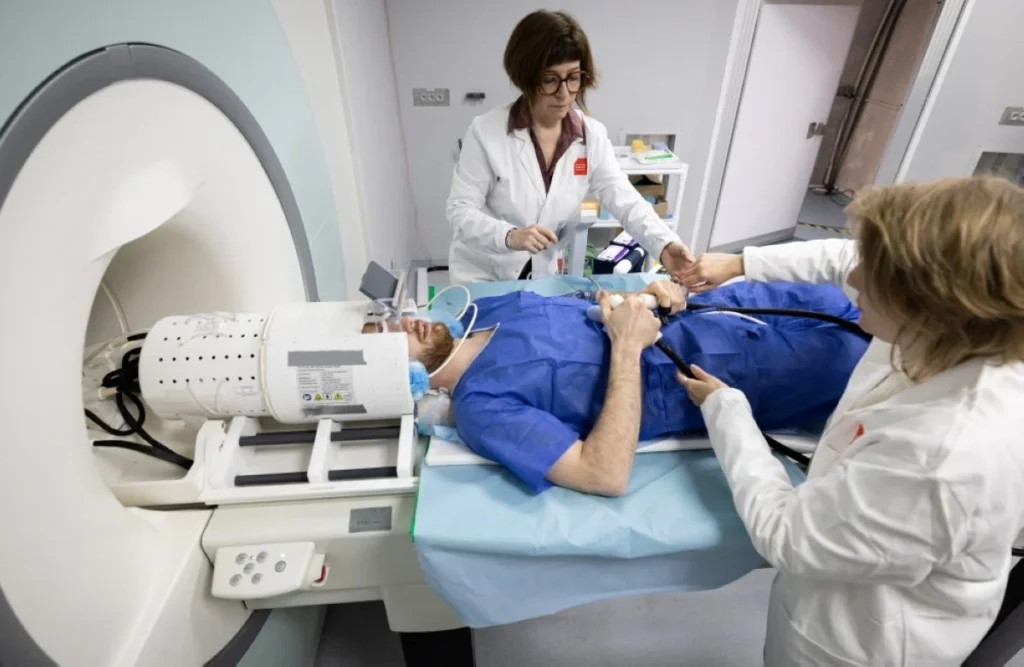An intriguing plot twist for the story would be if the unparalleled precision of the Iseult MRI scanner, while revealing unprecedented details about the human brain and its diseases, also unexpectedly uncovers a universally shared, previously undetectable neural structure among the volunteers. This discovery baffles the scientific community as it challenges the current understanding of brain anatomy and individuality.
 Pin
Pin Image Credit: kuwaittimes.com
Table of Contents
An intriguing plot twist for the story would be if the unparalleled precision of the Iseult MRI scanner, while revealing unprecedented details about the human brain and its diseases, also unexpectedly uncovers a universally shared, previously undetectable neural structure among the volunteers. This discovery baffles the scientific community as it challenges the current understanding of brain anatomy and individuality.
Researchers initially assume this shared structure to be some form of anomaly or artifact produced by the machine’s powerful magnetic field. However, upon closer inspection and additional scans from different subjects around the world, the presence of this enigmatic structure is consistently confirmed. The structure, which the research team tentatively names the “Nexus Cortex,” appears to play no role in any known neurological or cognitive functions. Its purpose and origin are entirely unknown.
This revelation sparks a global scientific endeavor to decipher the function and significance of the Nexus Cortex. Theories abound, ranging from it being a dormant part of the brain that once played a role in a now-lost sense of perception, to suggestions of it being a biological foundation for a collective human consciousness or even a new form of communication channel.
The discovery leads to a paradigm shift in how scientists understand the human mind, opening new doors to the treatment of neurological diseases. The Nexus Cortex, in its mystery, holds the potential to unlock new therapeutic techniques that could revolutionize mental health care, perhaps by enabling direct and precise modulation of neural activity or fostering a deeper connection between individuals at a neurological level.
The plot twist not only enhances the drama of the story but also integrates themes of unity, the potential for human evolution, and the endless possibilities that lie in the unknown regions of our own biology. It questions the very nature of individuality and consciousness, inviting readers to speculate on the hidden capabilities of the human brain and the profound implications of such a discovery on society, ethics, and our understanding of ourselves.
The Ultra-Powerful MRI Machine Lighting Up the Mysteries of the Human Brain
 Pin
Pin Image by: HappiestHealth.com
The exploration of the human brain, an intricate and enigmatic organ responsible for our thoughts, emotions, and actions, has always fascinated scientists and researchers. Advances in technology have steadily opened new vistas for understanding this complex organ’s inner workings. One of the most remarkable strides in this pursuit is the development of an ultra-powerful Magnetic Resonance Imaging (MRI) machine, a breakthrough achieved through the collaboration of French and German engineering. This monumental device stands as a testament to two decades of meticulous research and innovation, positioning itself at the frontier of neuroscience.
Nestled within a colossal cylinder, measuring five meters in both length and height, the machine is powered by an awe-inspiring 132-tonne magnet. This magnet, remarkable in its strength, is energized by a coil that channels a staggering current of 1,500 amps. Such immense power enables the machine to generate a magnetic field of 11.7 teslas, far surpassing the capability of conventional MRI scanners used in hospitals and research facilities, which typically operate at 1.5 to 3 teslas.
The design accommodates a 90-centimeter opening, allowing humans to slide into the heart of this technological marvel. This feature is not just an engineering achievement but also a gateway for scientists to embark on an unparalleled journey into the human brain.
The development of this ultra-powerful MRI scanner is part of a broader effort that sees the United States and South Korea also venturing into the creation of similarly potent machines. However, unlike their French and German counterparts, these nations have yet to commence human scans, making the European project a pioneering endeavor in its field.
One of the primary ambitions driving the creation of such a formidable scanner is to significantly enhance our grasp of brain anatomy and its functional dynamics. Traditional MRI techniques have already shed light on how the brain springs into action when engaged in recognizing faces, places, or words, pinpointing specific areas within the cerebral cortex that drive these processes. However, the potency of the 11.7-tesla magnet opens new horizons for a deeper, more nuanced understanding of these phenomena.
Nicolas Boulant, the project’s scientific director, envisions utilizing this cutting-edge technology to unravel the intricacies linking the brain’s structural configuration with its cognitive capabilities. This endeavor aims to dissect the mechanisms underlying everyday mental activities, from reading a book to performing mental arithmetic, with unprecedented clarity and precision.
This groundbreaking scanner not only marks a significant leap in neuroscientific research but also ignites hope for unraveling the mysteries of the human brain. By lighting up its regions with unmatched detail, scientists stand on the brink of untangling the complex web of neural activities that give rise to the mosaic of human cognition and consciousness.
Revolutionizing Neurological and Psychiatric Disorder Research: The Groundbreaking Role of the Ultra-Powerful MRI Scanner
The trail toward comprehending and potentially curtailing the progression of Alzheimer’s disease, along with other neurodegenerative disorders like Parkinson’s, and mental health conditions such as depression and schizophrenia, appears to be taking a revolutionary turn with the advent of an ultra-powerful MRI scanner. Developed by a collaboration between French and German engineers, this scanner is not just a marvel of technological advancement; it’s a beacon of hope for millions worldwide affected directly or indirectly by these conditions.
At the heart of this ambitious quest is the goal to illuminate the shadowy corners of neurological and psychiatric conditions. Anne-Isabelle Etienvre, a researcher at the French Alternative Energies and Atomic Energy Commission (CEA), underscores the importance of understanding specific brain regions, notably the hippocampus. The hippocampus’s critical role in Alzheimer’s disease is well-documented, but the intricate details of how cells function within this area remain elusive. By peering into the depths of the cerebral cortex with an unprecedented clarity provided by the scanner’s 11.7-tesla magnet, scientists hope to unravel the mysteries of cellular dynamics that could be key to understanding, diagnosing, and treating Alzheimer’s.
The exploration extends to the pharmacodynamics of psychiatric medications, with lithium — a common treatment for bipolar disorder — being a prime example. By mapping how lithium distributes and interacts within the brain, the research could pave the way for personalized medicine approaches in psychiatric care. Understanding the specific brain regions targeted by lithium and how different patients’ brains react to the drug could revolutionize treatment protocols, ensuring that those likely to benefit the most from lithium therapy receive it, while sparing others from unnecessary side effects.
While the ultimate aim is to conquer diseases that have long plagued humanity, the path there is meticulous and requires patience. Etienvre’s vision encompasses not just a deeper understanding of these conditions but also the potential for earlier diagnosis and more effective treatment strategies. However, it’s crucial to note that this groundbreaking tool, named Iseult, is not yet ready to be a clinical diagnostic tool within the realms of hospitals and medical centers. Nicolas Boulant, the project’s scientific director, emphasizes that while Iseult’s immediate function is geared more towards research and discovery, the knowledge gleaned from this next generation of brain imaging will eventually seep into clinical practices, enriching diagnostic and therapeutic avenues.
In the interim, the team plans to recruit healthy volunteers for brain scanning sessions, laying the groundwork for future studies involving patients with specific conditions. This cautious approach underlines the complexity and the nascent stage of this technology’s application in direct patient care. As we stand on the brink of potentially transformative breakthroughs in understanding and treating some of the most challenging neurodegenerative and psychiatric disorders, the promise of this ultra-powerful MRI scanner shines as a testament to human ingenuity and the relentless pursuit of knowledge for the betterment of society.
Video: World's Most Powerful MRI Scans First Images Of Human Brain
FAQs: World's Most Powerful MRI Scans First Images of Human Brain
The world’s most powerful MRI is a 132-tonne magnet that operates at 11.7 teslas, significantly more powerful than the standard MRIs in use today.
This MRI was developed through a collaborative effort between French and German engineers, representing two decades of dedicated research.
Its powerful 11.7-tesla magnet allows for unprecedented clarity and detail in brain imaging, far surpassing the capabilities of typical MRI scanners.
The primary goal is to deepen our understanding of the brain’s anatomy and the cognitive processes it controls. Researchers aim to explore the workings of the brain in much greater detail than has been possible before.
Yes, this EU-based project has successfully conducted the first images of the human brain, marking a significant milestone in neuroscientific research.
This MRI could revolutionize the diagnosis and understanding of neurological and psychiatric disorders by providing detailed images that help in the identification of previously undetectable abnormalities.
Yes, the United States and South Korea are working on developing similar high-power MRI scanners, but they have not yet conducted human scans.
The MRI scanner has a 90-centimeter opening, which accommodates the human body, providing a balance between comfort and the space needed for high-resolution imaging.
Scientists expect that this MRI will illuminate the brain’s inner workings in ways never before possible, potentially leading to breakthroughs in understanding cognitive functions and the treatment of brain-related disorders.
The project began approximately twenty years ago, highlighting the long-term commitment and collaboration between nations to push the boundaries of medical imaging technology.




























